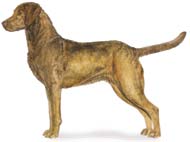INSTANT PROMOTION - LIMITED TIME OFFER - GET YOUR PUPPY COUPON TODAY
Hicksville: 516-938-7877
Lynbrook: 516-825-7877
Hicksville: 516-938-7877
Lynbrook: 516-825-7877
Currently we do not have any Chesapeake Bay Retriever Puppies available.
Please complete the form below to be notified when they are back in our stores.

Height: Female: 21 – 24 inches; Males: 23 – 26 inches. Weight: Females: 55 – 70 lbs.; Males: 65 – 80 lbs.
Colors: Dead grass (straw to bracken), sedge (red-gold), or any shade of brown. Dead grass color is preferred for hunting. White spots may appear on chest, toes, and belly. The smaller the spots the better. Coat: Chessies have a double coat. Thick and reasonable with a harsh, oily, outer coat and a dense, fine, wooly undercoat. Fur is moderately short and coarse. They have no beard or brow. The tail has slight feathering.
Temperament: Chesapeake Bay Retrievers are responsive, industrious, serious and aware. They are hard and diligent workers, willing to swim for a long time to retrieve their game. They are loyal and gentle with children. They can be wary of strangers, and tend to have a sharper personality than the other retrievers. They are training savvy, very responsive. Chessies are intelligent, affectionate with family and happiest in the country. They may react if provoked, and give off a slight odor this isn’t unpleasant. With Children: Yes, gets along extremely well with children. Although, they may react if provoked. With Pets: Yes, Chessies dominate other pets, but accept them. As with introducing any animals, supervision is best. Special Skills: Duck retriever, field sports dog and family pet.
Watch-dog: Very High. Chesapeakes notice small and large changes alike and will alert you. Guard-dog: High.
Care and Brush with a firm bristle brush. Bathe only when necessary as the Chesapeake Bay Retrievers coat has a natural waterproofing oil to it. They will need a great deal of vigorous activity including swimming to maintain peak physical condition. Training: Chesapeake Bay Retrievers are strong dogs who are territorial and are not recommended for the inexperienced new dog owner. They will need firm training and good management. A consistent, but kind approach is the most successful. Good news, though, the Chesapeake is highly trainable. Learning Rate: Medium. Obedience – Medium. Problem Solving – Medium.
Activity: Indoors – Low. Outdoors – Very High. Chesapeakes are determined to do their job. Living Environment: Chesapeake Bay Retrievers are generally considered a country dog rather than a city dog, but will adapt to urban living if giving plenty of exercise and space. An owner of a Chesapeake Bay Retriever should be a strong, consistent leader who wants a good watchdog that will be affectionate and athletic. The best owner for this type of dog would be an experienced, active owner living a rural area.
Health Issues: Hip dysplasia, PRA (Progressive Retinal Atrophy). Other health concerns include dwarfism, entropion, and epilepsy.
Life Span: 10 – 13 years. Litter Size: 7 – 8 puppies.
Country of Origin: USA History: Their name comes from the Chesapeake Bay in Maryland, USA. An American breed, the Chessie was created from English stock. The legend of the Chesapeake Bay Retriever is that in 1807 a ship wrecked off the coast of Maryland, and along with the survivors (one being a British army captain) came two Newfoundland pups that survived. The pups were a male and a female, named “Sailor” and “Canton”, Canton being the name of the ship. The survivors were welcomed into the home of Mr. George Law and cared for, and in return the army captain gave the Newfies to his family. the puppies were of different colors. Sailor was dingy red with yellow eyes, while Canton was black. The two shipwrecked Newfoundland dogs were then bred with the local dogs around town, possibly including Otterhounds, Indian dogs, pointers, setters and Irish Water Spaniels to produce a tireless hunter and guard dog. The Curl-Coated and Flat-Coated Retrievers are said to have played a role in the development of the Chessie as well. They were trained as duck retrievers, and were well known for being one of the best at what they do. Records from the 1800s reveal that the dogs averaged taking down thousands of ducks every Fall. The breed was made more tough and versatile due to cold salty waters that the Chessie retrieved from. They were also well known for being able to spot and remember where all the ducks fell, and being able to retrieve them. The breed became a favorite among duck hunters in the area. The entire development and recognition of the breed took almost 100 years. By the 1900s the breed was recognized and popular among serious duck hunters. Although not as well suited to an environment without a job, the Chesapeake Bay Retriever is slowly finding its way into the homes of families across the United States.
First Registered by the AKC: 1878 AKC Group: Sporting Group Class: Gundog Registries: AKC, ANKC, CKC, FCI (Group 8), KC (GB), UKC